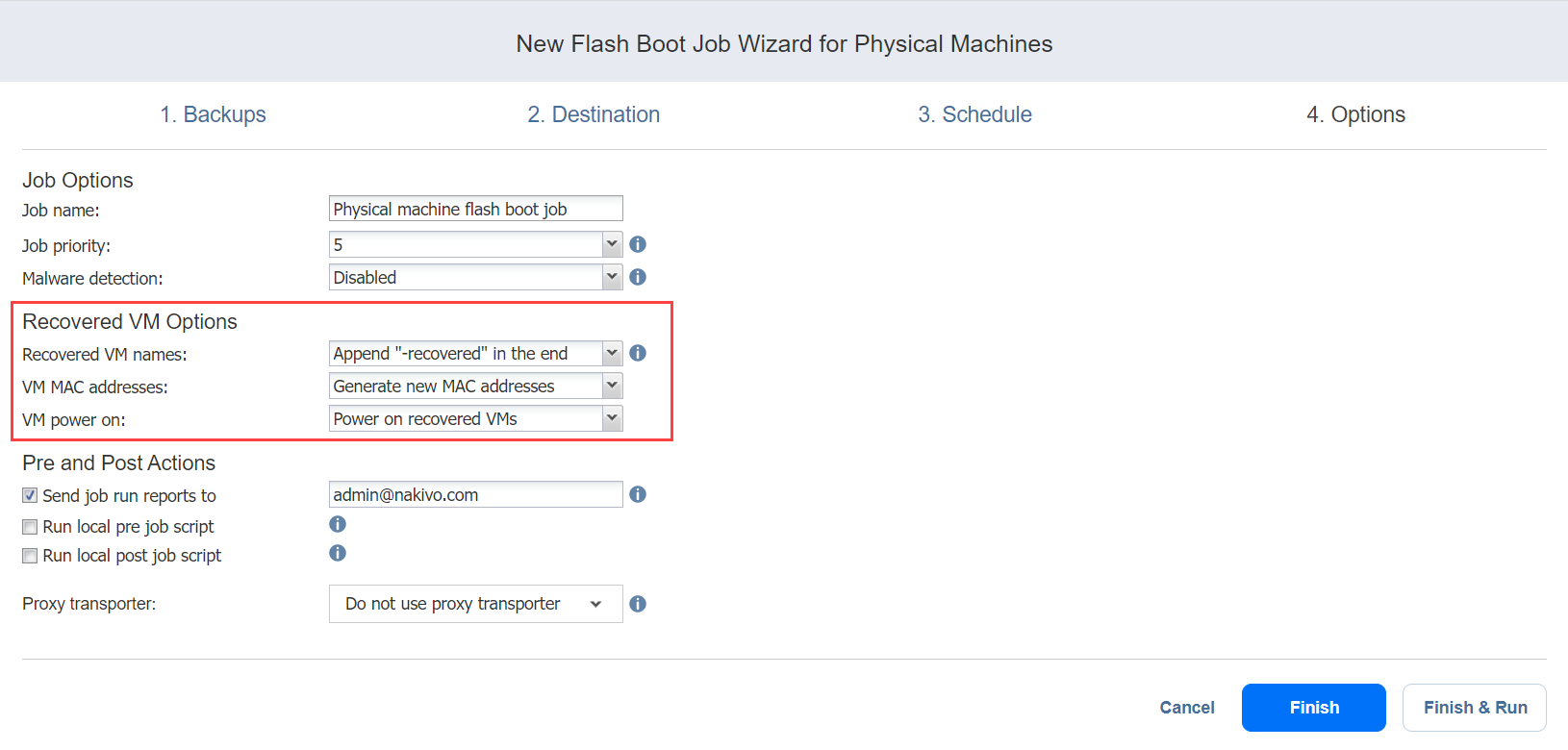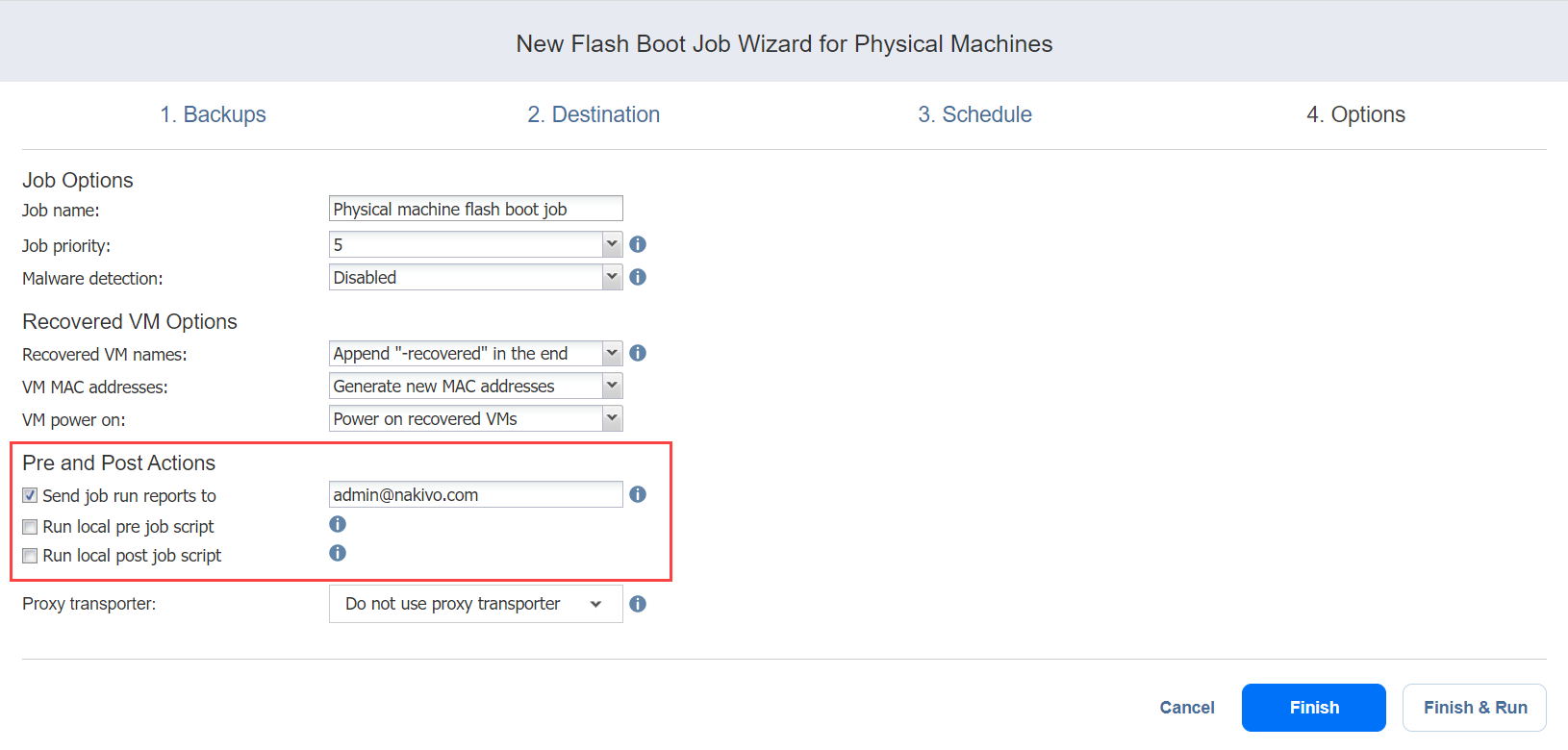Flash Boot Job Wizard for Physical Machine: Options
On the Options page of the wizard, specify a job name, set up recovered VM options, and choose data routing.
Job Options
In this section, specify a job name and a priority level, and enable malware detection. Proceed as described below:
Job Name
In the Job Options section, enter the name for the job.
Job Priority
Select a job priority level between 1 and 5, with 1 being the highest priority. Jobs with higher priority levels are prioritized by Transporters during job processing.
Note
This option is only available in the Enterprise, Enterprise Essentials, Enterprise Plus, MSP Enterprise, and MSP Enterprise Plus editions.
Malware Detection
With this option enabled, the backups are scanned for malware using the configured antivirus software on the scan server. Optionally, if you have selected Enabled for the Malware detection option, click the settings link to configure the following options:
-
Scan server: Select a specific scan server for the job or leave the Default setting. If Default is selected, the Transporter is used as the scan server and can support a maximum of 2 concurrent scan tasks.
Notes
-
For the Default option, if the Repository Transporter is the installed Transporter, it require the master password to function as the scan server.
-
For more details on the requirements for Scan Server, refer to the Feature Requirements.
-
-
Scan type: Choose between the Deep scan and the Quick scan:
-
Deep scan: When this option is selected, the antivirus software scans the entire backup and may take longer to complete.
-
Quick scan: When this option is selected, the antivirus software scans only OS disks in the backup.
-
-
If malware is detected: Choose the behavior if malware is detected:
-
Fail the recovery job: With this option, the recovery process fails in case the job has only one machine. If the job has several machines, the infected machines are skipped and the job continues to run.
-
Continue and recover to isolated network: When this option is selected, the recovery job completes the scanning process and recovers the infected machines to a temporary isolated network.
-
-
Scan timeout: Specify the timeout for the malware detection process. If the specified amount of time is exceeded, the recovery job fails.
-
Click Apply when you’re done.
Recovered VM Options
In this section, specify VM names, generate VM MAC addresses, and choose whether you want to power on recovered VMs or not.
Specifying VM Names
NAKIVO Backup & Replication allows you to change the names of recovered VMs so that you can distinguish between recovered VMs and the source physical machines. By default, the text “- recovered” is appended to the end of the recovered VM name.
To change VM names, choose one of the following options in the Recovered VM Options section:
-
Append “-recovered” in the end: Source machine names are used for recovered VM names and “-recovered” is added after the recovered VM name.
-
Leave recovered VM names as is: Recovered VM names are identical to the source machine names.
-
Enter custom recovered VM names: Allows you to enter custom names for recovered VMs.
Generating VM MAC Addresses
In the Recovered VM Options section, choose one of the following options in relation to recovered VM MAC addresses:
-
Generate new MAC addresses: A new MAC address is generated for each recovered VM.
-
Do not generate new MAC addresses: The recovered VMs have the same MAC address as the source machines.
Powering Recovered VMs
To power on the recovered VMs, choose the VM power on option.
Pre and Post Actions
NAKIVO Backup & Replication allows you to run a script before Flash boot begins (a pre-job script) and after the boot of all VMs in the job has completed (a post-job script). The scripts can only be executed on the machine where the Director is installed. Also, you can set up email notifications for the job. Refer to Notifications & Reports for details.
Setting Up Email Notifications
NAKIVO Backup & Replication can send email notifications about the job completion status to specified recipients. This feature complements global notifications and allows you to configure notifications on a per-job level.
Note
To enable this option, make sure your Email settings are configured.
To send email notifications, do the following:
In the Pre and Post Actions section:
-
Select Send job run reports to.
-
Specify one or more email addresses in the text field. Use semicolons to separate multiple email addresses.
Setting Up a Pre Job Script
To run a script before the product begins replicating VMs:
-
Place a script file on the machine where the Director is installed.
-
In the Pre and Post Actions section, select the Run local pre job script option.
-
Script path: Specify a local path to the script on the machine where the Director is installed. A script interpreter should be specified.
Example (Windows): cmd.exe /c D:\script.batExample (Linux): bash /root/script.sh
-
Job behavior: Choose one of the following job behaviors in relation to script completion:
-
Do not wait for the script to finish: With this option selected, the product runs the script and starts replicating VMs at the same time.
-
Wait for the script to finish: With this option selected, VM replication is started only after the script is completed.
-
-
Error handling: Choose one of the following job behaviors in relation to script failure:
-
Fail the job on script failure: With this option selected, the job is failed and VM replication is not performed if the script has failed.
-
Continue the job on script failure: With this option selected, the job performs VM replication even if the script has failed.
-
Specify the following parameters in the dialog box that opens:
Setting Up a Post Job Script
To run a script after the product has finished backing up all VMs:
-
Place a script file on the machine where the Director is installed.
-
In the Pre and Post Actions section, select the Run local post job script option.
-
Specify the following parameters in the dialog box that opens:
-
Script path: Specify a local path to the script on the machine where the Director is installed. A script interpreter should be specified.
Example (Windows): cmd.exe /c D:\script.batExample (Linux): bash /root/script.sh
-
Job behavior: Choose one of the following job behaviors in relation to script completion:
-
Wait for the script to finish: With this option selected, the job is in the “running” state until the script is completed.
-
Do not wait for the script to finish: With this option selected, the job is completed even if the script execution is still in progress.
-
-
Error handling: Choose one of the following job behaviors in relation to script failure:
-
Continue the job on script failure: With this option selected, script failure does not influence the status of the job.
-
Fail the job on script failure: With this option selected, if the script has failed, the job status will be set to “failed” even if VM replication has been successful.
-
Data Routing
In case the Transporter assigned to a Backup Repository cannot use iSCSI port 3260 because the port is occupied by other services, you can set data routing: a proxy Transporter can be used to forward the iSCSI target exposed from the Backup Repository to the target host. To set data routing, go to the Data routing section and choose a proxy Transporter from the list of available Transporters.
Completing Flash Boot Job Wizard for Physical Machine
Click Finish or Finish & Run to complete the job creation.
Note
If you click Finish & Run, you will have to define the scope of your job. Refer to Running Jobs on Demand for details.



